Click on images to enlarge

infestation (Photo: Sheldon Navie)
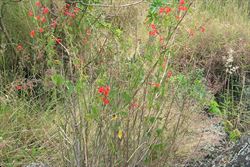
habit of large plant (Photo: Forest and Kim Starr, USGS)
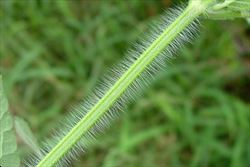
close-up of hairs on younger stem (Photo: Sheldon Navie)
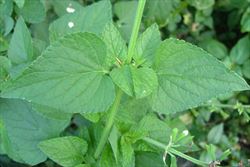
leaves (Photo: Sheldon Navie)
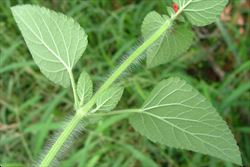
leaf undersides (Photo: Sheldon Navie)
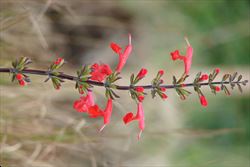
elongated flower cluster (Photo: Forest and Kim Starr, USGS)
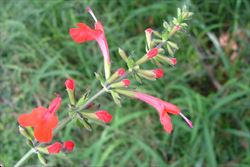
close-up of tubular red flowers (Photo: Sheldon Navie)
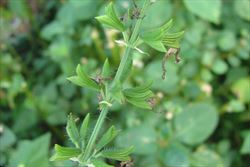
immature fruit (Photo: Sheldon Navie)
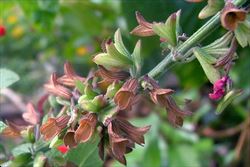
close-up of mature fruit (Photo: Sheldon Navie)
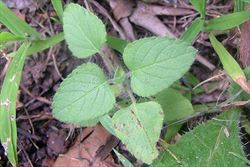
seedling (Photo: Sheldon Navie)
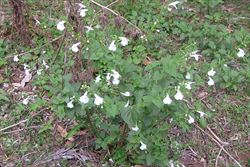
habit of Salvia coccinea 'Snow Nymph' (Photo: Sheldon Navie)
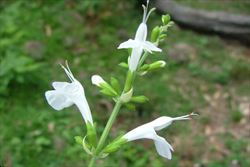
white flowers of Salvia coccinea 'Snow Nymph' (Photo: Sheldon Navie)
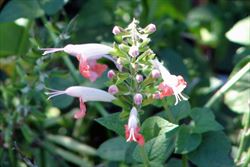
salmon pink and white flowers of Salvia coccinea 'Coral Nymph' (Photo: Forest and Kim Starr, USGS)
Scientific Name
Salvia coccinea Juss. ex Murray
Synonyms
Salvia pseudococcinea Jacq.
Family
Labiatae (South Australia)Lamiaceae (Queensland, New South Wales, the ACT, Victoria, Tasmania, Western Australia and the Northern Territory)
Common Names
blood sage, cherry red sage, crimson sage, hummingbird sage, red flowering salvia, red sage, red salvia, rosy sage, scarlet sage, scarlet salvia, South American sage, Texas sage, Texas salvia, tropical sage, wild salvia
Origin
The exact native range of this species is obscure, but it is thought to be native to south-eastern USA (i.e. Alabama, Florida, Georgia, Louisiana, Mississippi, South Carolina and Texas), Mexico, the Caribbean, Central America (i.e. Belize, El Salvador and Guatemala) and tropical South America (i.e. Brazil, Colombia and Peru).
Cultivation
Several cultivars of this introduced garden plant (i.e. ornamental) are still common in cultivation in Australia. These include 'Lady In Red', with deep red flowers, 'Coral Nymph', with salmon pink and white flowers, and 'Snow Nymph' (also known as 'Alba'), with white flowers.
Naturalised Distribution
Widely naturalised in eastern Australia (i.e. in eastern Queensland and the coastal districts of eastern New South Wales). Also naturalised on Lord Howe Island and Norfolk Island.
Naturalised overseas on La Réunion and on several Pacific islands (e.g. Fiji, French Polynesia, New Caledonia, Niue, Tonga and Hawaii).
Habitat
It is a weed of open woodlands, riparian vegetation, disturbed sites, waste areas, roadsides, gardens and occasionally also plantation crops in tropical, sub-tropical and warmer temperate regions.
Habit
A long-lived (i.e. perennial), upright (i.e. erect), herbaceous plant usually growing about 1 m tall, but occasionally reaching up to 1.5 m in height.
Distinguishing Features
- a long-lived herbaceous plant usually growing up to 1.5 m tall.
- its stems are covered with short hairs as well as long spreading hairs.
- its paired leaves (1.5-6 cm long and 1-5 cm wide) have toothed margins and densely hairy undersides.
- its bright red, pink or white flowers (15-30 mm long) are borne in groups along elongated clusters at the tips of the stems.
- these flowers have a small upper lobe and a much larger and broader lower lobe.
Stems and Leaves
The stems are covered with short hairs and long spreading hairs (i.e. they are pubescent).
The leaves are arranged in pairs along the stems and borne on stalks (i.e. petioles) that are usually 0.5-2 cm long (occasionally longer). They are egg-shaped in outline (i.e. ovate) to somewhat triangular in shape with toothed (i.e. crenate or serrate) margins and pointed to rounded tips (i.e. acute to obtuse apices). These leaves (1.5-6 cm long and 1-5 cm wide) have hairless (i.e. glabrous) to sparsely hairy (i.e. puberulent) upper surfaces and densely hairy (i.e. pubescent) undersides.
Flowers and Fruit
The tubular flowers (15-30 mm long) are borne in elongated clusters at the tips of the stems (i.e. terminal racemes) and are arranged in groups of 3-10 (i.e. verticils) above small leafy bracts (up to 1 cm long). Each flower is borne on a short stalk (i.e. pedicel) up to 8 mm long and has five dull purple or green sepals (7-10 mm long). These sepals are hairy and fused together into a finely ribbed tube (i.e. calyx tube) which has a rounded upper lobe (i.e. obtuse upper lip) and a two-toothed lower lobe (i.e. two-toothed lower lip). The petals are hairy (i.e. pubescent) and fused together at the base into a tube (i.e. corolla tube). They are usually bright or dark red, but may occasionally be white or salmon pink, and separate into two lobes (i.e. an upper and lower lip). The upper lip is short and narrow, while the lower lip is longer and much broader. Each flower also has two stamens (4 mm long) and an ovary topped with a style and unequally two-lobed stigma.
The fruit (i.e. schizocarp) splits into four one-seeded segments (i.e. mericarps or nutlets) when mature. These brown 'seeds' (about 3 mm long) are narrowly egg-shaped (i.e. narrowly-ovoid) and smooth in texture.
Reproduction and Dispersal
This species reproduces mainly by seed. These seeds can be dispersed by wind or water, or in dumped garden waste.
Environmental Impact
Red salvia (Salvia coccinea) is regarded as an environmental weed in Queensland and New South Wales.
Legislation
Not declared or considered noxious by any state government authorities.
Similar Species
Red salvia (Salvia coccinea) may be confused with scarlet sage (Salvia splendens), and occasionally also with rose-leaf sage (Salvia involucrata). These species can be distinguished by the following differences:
- red salvia (Salvia coccinea) is moderately-sized plant (growing up to 1.5 m tall) with very hairy stems and leaf undersides. Its flowers are usually red, but may occasionally be white or salmon pink.
- scarlet sage (Salvia splendens) is moderately-sized plant (growing up to 1 m tall) with hairless stems and leaf undersides. Its flowers are usually scarlet red, but may be a wide range of colours in cultivated plants.
- rose-leaf sage (Salvia involucrata) is relatively large plant (growing up to 2 m tall) with mostly hairless stems and leaf undersides. Its flowers are usually bright pink.

